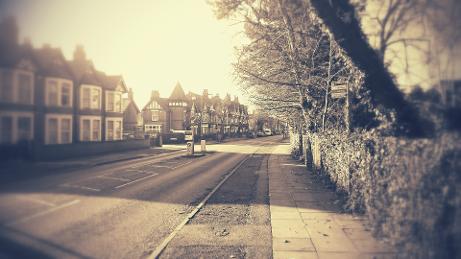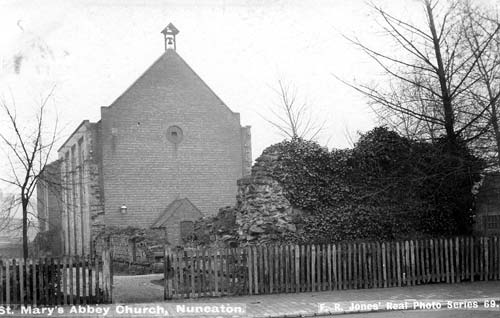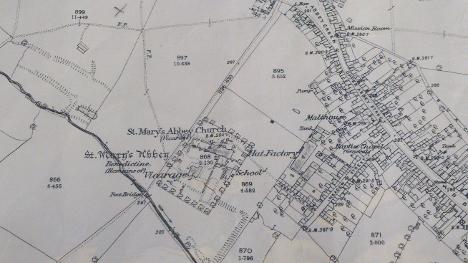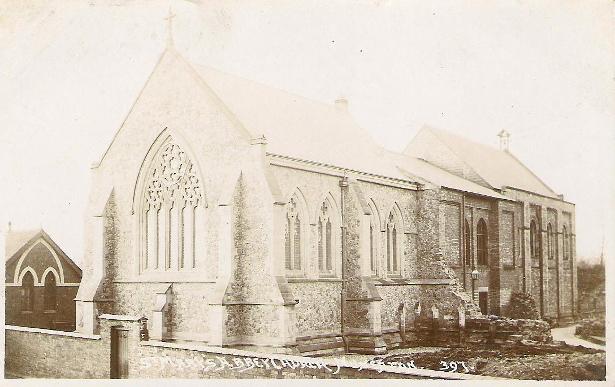The Early Years Of Manor Court Road

Manor Court Road as we know it today and a early photo with very young trees lining the road. Photo by myself (left) and Nuneaton Library (right)
Today you can drive down Manor Court Road and you'll notice the houses along this through-fare are different from most in Nuneaton. The area has been given a conservation order to preserve their original features, part in thanks to Nuneaton and Bedworth Council and the Nuneaton Civic Society. Next time you're passing have a look and you will see that the houses are decorated with some of the finest art work of its time. Most were built in the late 19th, early 20th century using Stanley Bros products and made by the fine hands of Nuneaton workers.
On this page we dip into the past and show you some of these fine houses in the lovely tree lined suburb, including Stanley's very own Manor House.
A Short History...............
The first signs of activity along this route happened long before Manor Court Road was thought about. The area is very important historically to the beginning of what we now know as Nuneaton. In the twelfth century the 'new' town was founded by a newly founded priory. Almost the entire Manor of Eaton was awarded to the Nuns by Robert de Beaumont, Earl of Leicester in 1155. In the later part of the century the market square had been laid out and a regular sequence of burgage plots* along Abbey Street (the 'high' street).
At the dissolution of the monasteries in 1540, King Henry VIII granted the manor and priory to Sir Marmaduke Constable, who converted the buildings into his manor house. His tomb still lies in St Nicholas Church. After his death the land then became part of the Paget family and in 1765 Henry Paget, Earl of Uxbridge sold all his holdings in Nuneaton to James Edward and Henry Tomkinson. This brings us up to the Victorian era and the Tomkinson family eventually association with Reginald Stanley.
*A burgage plot consisted of a house on a long and narrow plot. A rent was then paid to the lord of the manor.
The Victorian Era............
For nearly two hundred years the priory had been left in ruins after the death of Sir Marmaduke Constable and stood in fields isolated from Abbey Street and the Market Place. With the towns fast growing population, so came a bigger need for more houses and a place of worship for the Church Of England. The first steps where made by a man called Thomas Bottrill, he died in 1869 leaving a bequest of £400 towards the building of a new church and £2500 for its endowments, all with a proviso that it is built within ten years.
The foundation stone was laid on 26th April 1876 and the design of the Church and Vicarage were left to the well renowned Arts & Crafts architect of the time Clapton Rolfe.
For a number of years the church had no access road for its parishioners. Abbey Railway Station on Midland Road had been built in 1864 and the only route by road from Stockingford was along Arbury Road and Abbey Street. There was a footpath along the same line as the road now (see right), but in bad weather in made the route impossible for anything other than the swimming kind.
Reginald and his close associate James Tomkinson, planned to link the Cock & Bear Bridge with Abbey Green. The building of the road came with some very strong opposition as you will read shortly and it took a number of years to get the motion accepted.



The Development.............
Now St Mary's Church was in place the next step was surely a road to connect with Abbey Green and Stockingford. Stanley proposed to the board that Vernon Lane be closed as they planned the new road to link Midland Road and Arbury Road. A letter was sent to Mr Tomkinson and on the 1st July 1884, he sent a letter back to the Nuneaton Local Board of Health with his offer (See right)
The proposal didnt go down well. Mr George Ward (A local conservative and respected farmer) said it shouldn't be discussed until Mr Tomkinson is willing to change his offer and cover the cost of the new road. Reginald withdrew his motion to close Vernons Lane to foot and cart traffic as many workers used the route to and from the local collieries.
Two years later in 1886, at another local board meeting the proposal was again mentioned and the offer from Mr Tomkinson should be taken up this time with a slight change, closure of Vernons Lane only to carts. It was still causing arguments between Stanley and Ward. Ward could sense that the only people to benefit from this road would be coal mining cart's not the common man, the lands value would also shoot up with the inclusion of a road. Mr Stanley produced a letter with 828 names of ratepayers who where in favour of the building of the road. The Surveyor costed the building of the road to be £1100.
Voting took place on the proposal and it was 5 to 4 in favor of the road, but under the rules they needed two third's of members to be in favor to pass the movement, so it had to be a loss. Reginald's motion wasn't passed so it was back to the drawing board for now.
James Tomkinson's letter in the Nuneaton Observer
It took some 5 years for the road to be given the green light. The construction was done in two stages. The first part was from Abbey Green about 400 yards long and 50 yards wide in 1891. The second half completed down to the corner of the Cock and Bear and was finished in 1892 at a total cost of £13,000 all bore by the public's purse. The congregation at St Mary's could finally arrive by cart from both directions and soon they were to have neighbours joining them on the newly built thoroughfare.